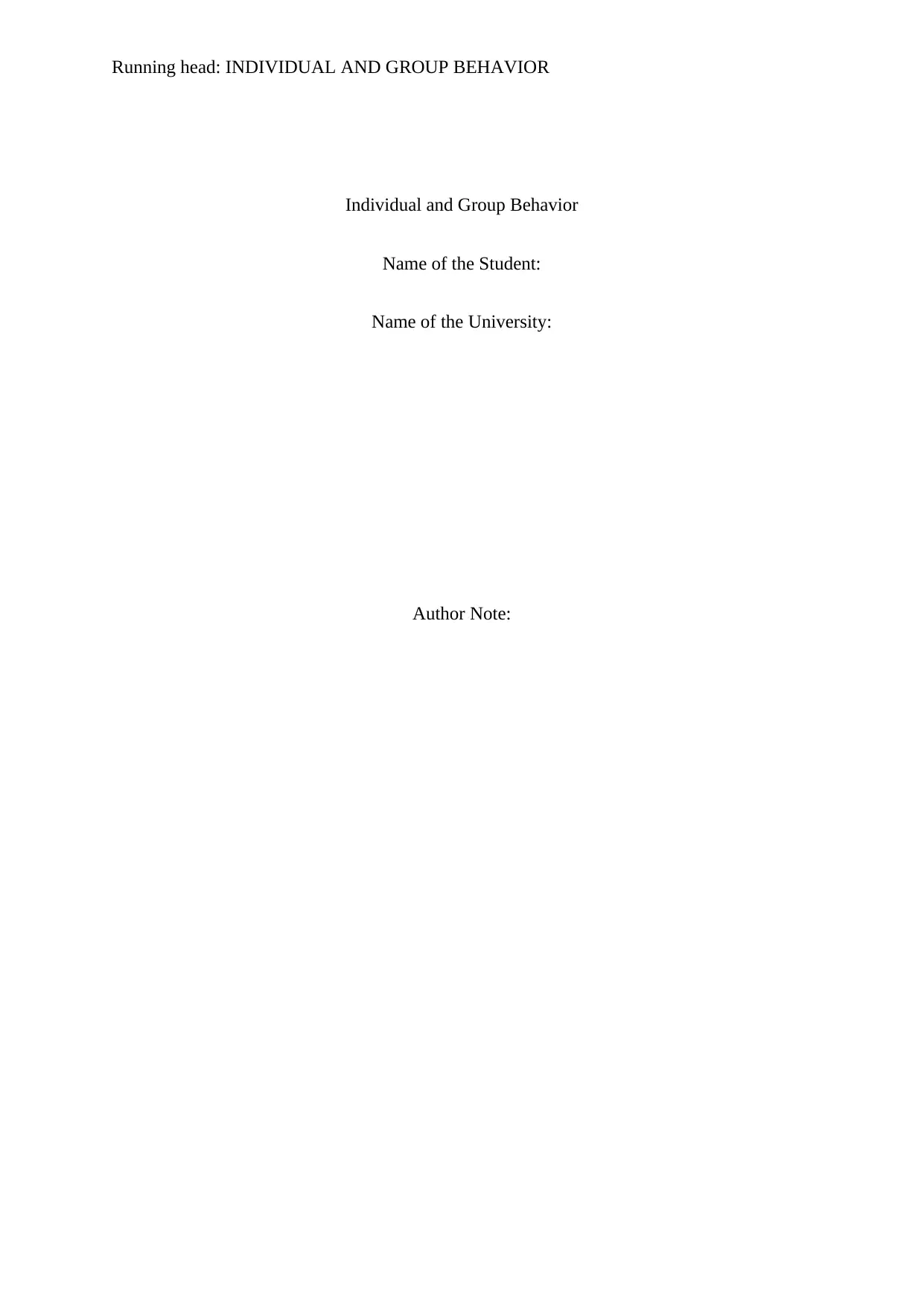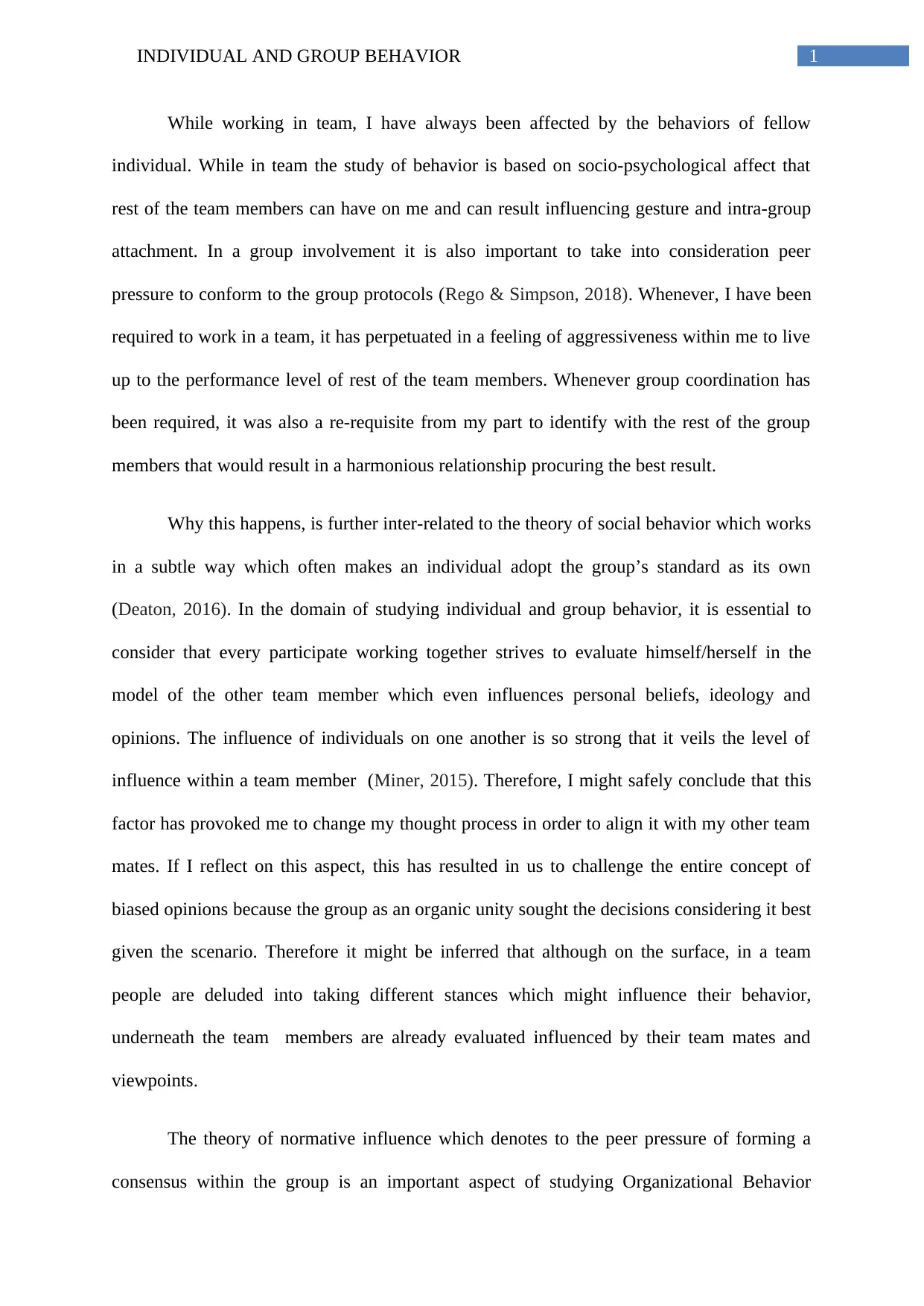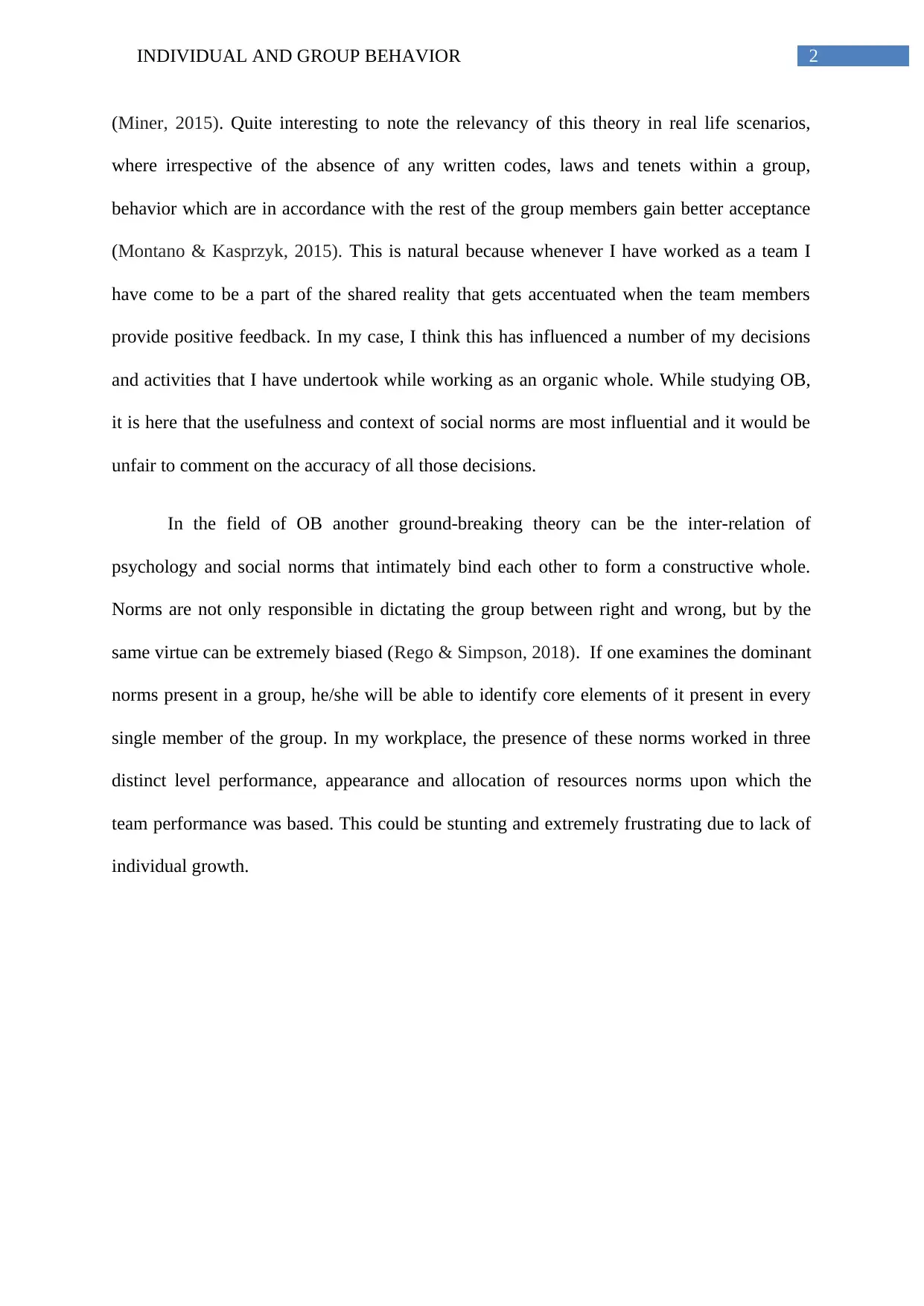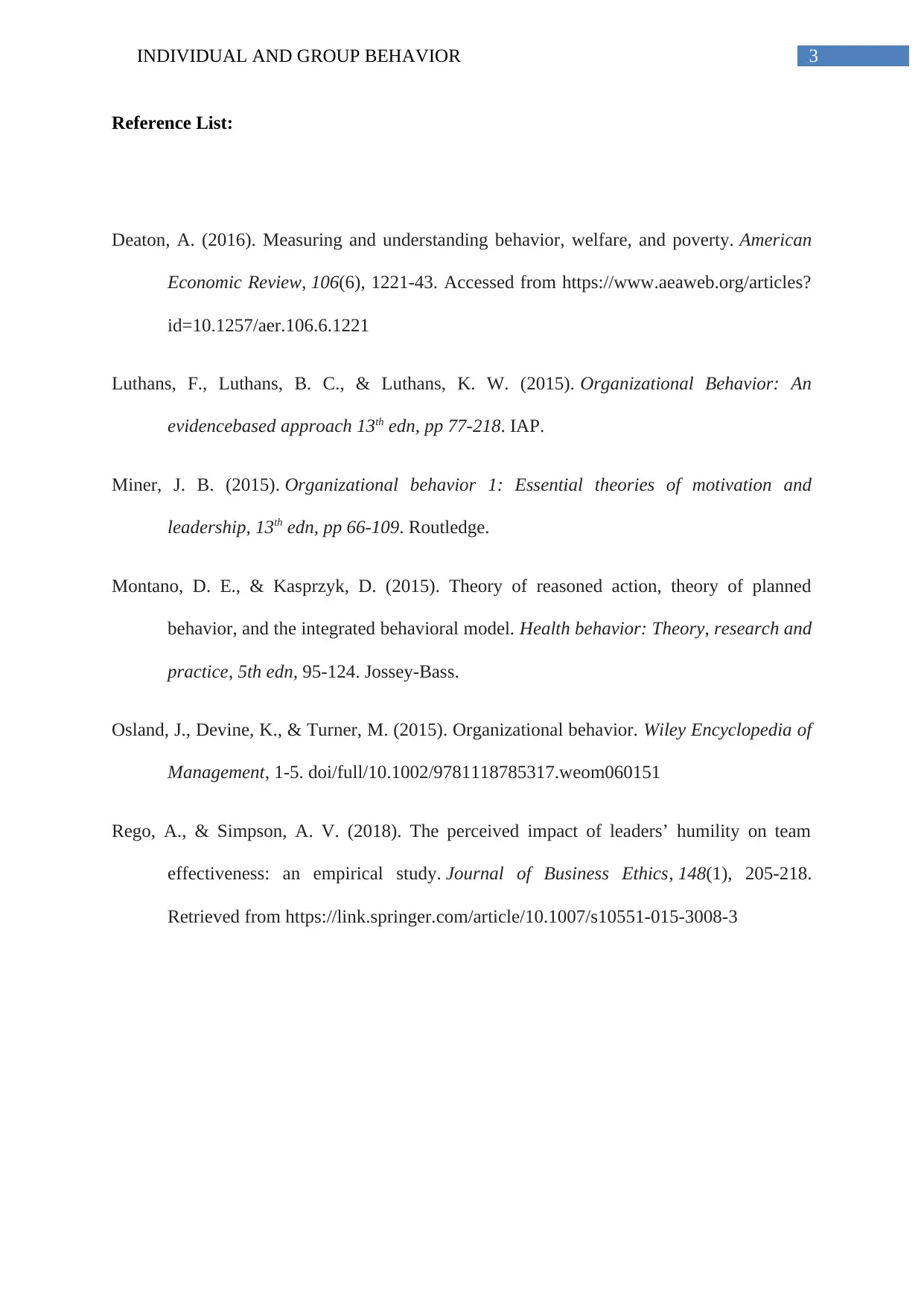Individual and Group Behavior
VerifiedAdded on 2021/06/17
|4
|920
|60
AI Summary
Contribute Materials
Your contribution can guide someone’s learning journey. Share your
documents today.

Running head: INDIVIDUAL AND GROUP BEHAVIOR
Individual and Group Behavior
Name of the Student:
Name of the University:
Author Note:
Individual and Group Behavior
Name of the Student:
Name of the University:
Author Note:
Secure Best Marks with AI Grader
Need help grading? Try our AI Grader for instant feedback on your assignments.

1INDIVIDUAL AND GROUP BEHAVIOR
While working in team, I have always been affected by the behaviors of fellow
individual. While in team the study of behavior is based on socio-psychological affect that
rest of the team members can have on me and can result influencing gesture and intra-group
attachment. In a group involvement it is also important to take into consideration peer
pressure to conform to the group protocols (Rego & Simpson, 2018). Whenever, I have been
required to work in a team, it has perpetuated in a feeling of aggressiveness within me to live
up to the performance level of rest of the team members. Whenever group coordination has
been required, it was also a re-requisite from my part to identify with the rest of the group
members that would result in a harmonious relationship procuring the best result.
Why this happens, is further inter-related to the theory of social behavior which works
in a subtle way which often makes an individual adopt the group’s standard as its own
(Deaton, 2016). In the domain of studying individual and group behavior, it is essential to
consider that every participate working together strives to evaluate himself/herself in the
model of the other team member which even influences personal beliefs, ideology and
opinions. The influence of individuals on one another is so strong that it veils the level of
influence within a team member (Miner, 2015). Therefore, I might safely conclude that this
factor has provoked me to change my thought process in order to align it with my other team
mates. If I reflect on this aspect, this has resulted in us to challenge the entire concept of
biased opinions because the group as an organic unity sought the decisions considering it best
given the scenario. Therefore it might be inferred that although on the surface, in a team
people are deluded into taking different stances which might influence their behavior,
underneath the team members are already evaluated influenced by their team mates and
viewpoints.
The theory of normative influence which denotes to the peer pressure of forming a
consensus within the group is an important aspect of studying Organizational Behavior
While working in team, I have always been affected by the behaviors of fellow
individual. While in team the study of behavior is based on socio-psychological affect that
rest of the team members can have on me and can result influencing gesture and intra-group
attachment. In a group involvement it is also important to take into consideration peer
pressure to conform to the group protocols (Rego & Simpson, 2018). Whenever, I have been
required to work in a team, it has perpetuated in a feeling of aggressiveness within me to live
up to the performance level of rest of the team members. Whenever group coordination has
been required, it was also a re-requisite from my part to identify with the rest of the group
members that would result in a harmonious relationship procuring the best result.
Why this happens, is further inter-related to the theory of social behavior which works
in a subtle way which often makes an individual adopt the group’s standard as its own
(Deaton, 2016). In the domain of studying individual and group behavior, it is essential to
consider that every participate working together strives to evaluate himself/herself in the
model of the other team member which even influences personal beliefs, ideology and
opinions. The influence of individuals on one another is so strong that it veils the level of
influence within a team member (Miner, 2015). Therefore, I might safely conclude that this
factor has provoked me to change my thought process in order to align it with my other team
mates. If I reflect on this aspect, this has resulted in us to challenge the entire concept of
biased opinions because the group as an organic unity sought the decisions considering it best
given the scenario. Therefore it might be inferred that although on the surface, in a team
people are deluded into taking different stances which might influence their behavior,
underneath the team members are already evaluated influenced by their team mates and
viewpoints.
The theory of normative influence which denotes to the peer pressure of forming a
consensus within the group is an important aspect of studying Organizational Behavior

2INDIVIDUAL AND GROUP BEHAVIOR
(Miner, 2015). Quite interesting to note the relevancy of this theory in real life scenarios,
where irrespective of the absence of any written codes, laws and tenets within a group,
behavior which are in accordance with the rest of the group members gain better acceptance
(Montano & Kasprzyk, 2015). This is natural because whenever I have worked as a team I
have come to be a part of the shared reality that gets accentuated when the team members
provide positive feedback. In my case, I think this has influenced a number of my decisions
and activities that I have undertook while working as an organic whole. While studying OB,
it is here that the usefulness and context of social norms are most influential and it would be
unfair to comment on the accuracy of all those decisions.
In the field of OB another ground-breaking theory can be the inter-relation of
psychology and social norms that intimately bind each other to form a constructive whole.
Norms are not only responsible in dictating the group between right and wrong, but by the
same virtue can be extremely biased (Rego & Simpson, 2018). If one examines the dominant
norms present in a group, he/she will be able to identify core elements of it present in every
single member of the group. In my workplace, the presence of these norms worked in three
distinct level performance, appearance and allocation of resources norms upon which the
team performance was based. This could be stunting and extremely frustrating due to lack of
individual growth.
(Miner, 2015). Quite interesting to note the relevancy of this theory in real life scenarios,
where irrespective of the absence of any written codes, laws and tenets within a group,
behavior which are in accordance with the rest of the group members gain better acceptance
(Montano & Kasprzyk, 2015). This is natural because whenever I have worked as a team I
have come to be a part of the shared reality that gets accentuated when the team members
provide positive feedback. In my case, I think this has influenced a number of my decisions
and activities that I have undertook while working as an organic whole. While studying OB,
it is here that the usefulness and context of social norms are most influential and it would be
unfair to comment on the accuracy of all those decisions.
In the field of OB another ground-breaking theory can be the inter-relation of
psychology and social norms that intimately bind each other to form a constructive whole.
Norms are not only responsible in dictating the group between right and wrong, but by the
same virtue can be extremely biased (Rego & Simpson, 2018). If one examines the dominant
norms present in a group, he/she will be able to identify core elements of it present in every
single member of the group. In my workplace, the presence of these norms worked in three
distinct level performance, appearance and allocation of resources norms upon which the
team performance was based. This could be stunting and extremely frustrating due to lack of
individual growth.

3INDIVIDUAL AND GROUP BEHAVIOR
Reference List:
Deaton, A. (2016). Measuring and understanding behavior, welfare, and poverty. American
Economic Review, 106(6), 1221-43. Accessed from https://www.aeaweb.org/articles?
id=10.1257/aer.106.6.1221
Luthans, F., Luthans, B. C., & Luthans, K. W. (2015). Organizational Behavior: An
evidencebased approach 13th edn, pp 77-218. IAP.
Miner, J. B. (2015). Organizational behavior 1: Essential theories of motivation and
leadership, 13th edn, pp 66-109. Routledge.
Montano, D. E., & Kasprzyk, D. (2015). Theory of reasoned action, theory of planned
behavior, and the integrated behavioral model. Health behavior: Theory, research and
practice, 5th edn, 95-124. Jossey-Bass.
Osland, J., Devine, K., & Turner, M. (2015). Organizational behavior. Wiley Encyclopedia of
Management, 1-5. doi/full/10.1002/9781118785317.weom060151
Rego, A., & Simpson, A. V. (2018). The perceived impact of leaders’ humility on team
effectiveness: an empirical study. Journal of Business Ethics, 148(1), 205-218.
Retrieved from https://link.springer.com/article/10.1007/s10551-015-3008-3
Reference List:
Deaton, A. (2016). Measuring and understanding behavior, welfare, and poverty. American
Economic Review, 106(6), 1221-43. Accessed from https://www.aeaweb.org/articles?
id=10.1257/aer.106.6.1221
Luthans, F., Luthans, B. C., & Luthans, K. W. (2015). Organizational Behavior: An
evidencebased approach 13th edn, pp 77-218. IAP.
Miner, J. B. (2015). Organizational behavior 1: Essential theories of motivation and
leadership, 13th edn, pp 66-109. Routledge.
Montano, D. E., & Kasprzyk, D. (2015). Theory of reasoned action, theory of planned
behavior, and the integrated behavioral model. Health behavior: Theory, research and
practice, 5th edn, 95-124. Jossey-Bass.
Osland, J., Devine, K., & Turner, M. (2015). Organizational behavior. Wiley Encyclopedia of
Management, 1-5. doi/full/10.1002/9781118785317.weom060151
Rego, A., & Simpson, A. V. (2018). The perceived impact of leaders’ humility on team
effectiveness: an empirical study. Journal of Business Ethics, 148(1), 205-218.
Retrieved from https://link.springer.com/article/10.1007/s10551-015-3008-3
1 out of 4
![[object Object]](/_next/static/media/star-bottom.7253800d.svg)





